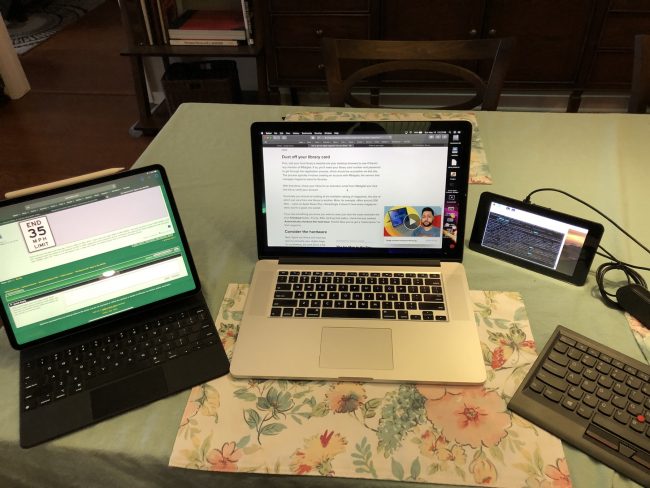
Some geek time today.
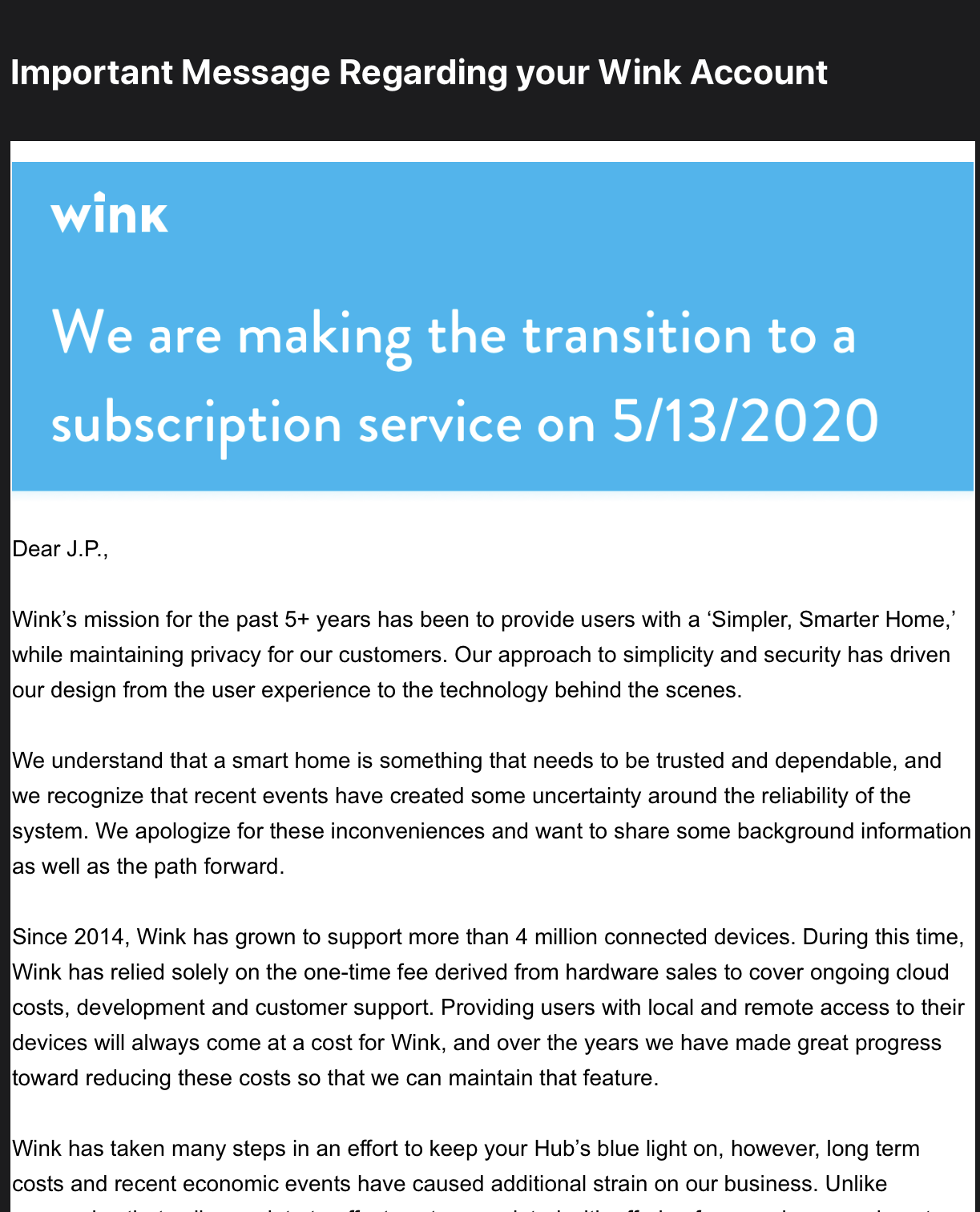
Years ago I picked up a couple of LED smart bulbs from Home Depot. As I recall, these particular bulbs were very affordable, adequate for what I had planned for them (I believe they were going in a guest bedroom), and they were branded GE. While we were using Philips Hue lights for out automation at the time (and still are today), there were notes online around the flexibility of these GE bulbs: they would be compatible with the Philips Hue hub or you could get a hub made by Wink and go with that. Home Depot had a special where they were practically giving the Wink hub away so I paid the minimal amount of cash they wanted for the hub and tried to integrate it into our smart home setup.
I was never satisfied with the Wink Hub. It became unresponsive too often and we were still moving in the Philips Hue direction. I abandoned the hub and basically forgot about it until it was recycled, along with the GE bulbs, when we moved to Chicago.
I received an email advising me my Wink Hub would no longer be functional after 5/13/20 unless I joined their subscription plan to provide continued service. The plan is $4.99 a month. There’s probably taxes too. There’s always taxes.
Looking at the calendar, the 13th of May is only a few days away. If I had invested more into the Wink Home Automation system I would be a very unhappy customer right now.
Now, in the grand scheme of things $4.99 per month doesn’t seem like a lot of money. But what doesn’t seem like a lot of money to me may seem like a lot of money to other people. Plus, I distinctly remember the Wink Hub box mentioning “No Subscription Fees!”.
It would appear that Wink has changed their mind.
As I mentioned in an earlier blog entry, I am becoming very subscription fatigued. All of these consumption and membership and automation based subscriptions can be very taxing on the household budget. The kicker is, Wink provides a luxury, a convenience. Why pay $60 per year just to be able to turn lights on and off with my smartphone? Yes, changing colors, automating on/off times, etc. is nice, but it’s not a necessity. I can still flip a switch.
I feel bad for the folks that have gone all in on the Wink ecosystem. I’ve been reading about consumers that have built Wink into their new construction; wall switches that rely on Wink, relays that fire off sprinklers and what not, relying on Wink. Unless they pay the subscription fee, all of these devices will become INOP in just a few days.
Sorry Wink, but that’s not the way to get people to love your ecosystem.
Companies like Wink are trying to move us to a subscription dependent future. That’s not a future I want to be part of. Intrigued by these developments, I may spend some of my geek time researching open source alternatives to share on the various home automation forums I’m part of to see how folks can continue to control their devices on their terms. There’s almost always an open source solution.
Four days notice of a support paradigm shift is not the way to flip a switch.

People here in the 21st century like to make fun of the screeching noises our modems made in the late 20th century. My husband and I were the outliers when we made our home in a our small apartment in 1996; we had two phone lines, enabling us to both be online at the same time. We finished our time with America Online in that apartment; by the time we had moved to our first house in 1997 we had moved to a local Internet Service Provider and again we had two phones lines to accommodate our two 56K baud modems.
Good times.
I vividly remember the Internet of the late 20th century. Heck, I vividly remember going online before the “Information Superhighway” was touted as a thing; I was dialing into local Bulletin Board Services and text based online services with my Commodore 64 in 1986. It was not much later that I was working for then the second largest computer company in the world where everyone had a computer on their desk. All of our computers were connected and if we knew the right path to get to another company, we could send email from our desk to a friend’s desk at another company hundreds of miles away.
Edward Snowden wrote about this in his book, “Permanent Record”: the Internet (and its precursors) was a much friendlier place back in the day. In the circles where I traveled, and I traveled in many online circles back then, our focus was on communication and information exchange. It would be literally decades before people aspired to be “influencers”. Honestly, getting online, navigating the systems, and actually staying connected was difficult for the average joe and because of this, there wasn’t a lot of flooding of misinformation, deception, and propaganda. Sure, we had bulletin boards where we talked about conspiracy theories and I kept up with the few folks I knew associated with ACT-UP, but it seemed to be very rare where there was so much spin and deception running rampantly across our screens.
I can’t get through one screen of Facebook without rolling my eyes at the stupidity of some of the people I have on my “friends” list. The list is growing shorter by the day.
I firmly believe our society was not prepared for the freedom offered with all information being instantly available. I don’t know that humans are truly equipped to handle this much information, especially when so many bad actors are easily getting onto the “Information Superhighway” to purposely disrupt, deceive, and destroy.
The Internet was suppose to bring us together, not rip us apart. But that’s exactly what it’s doing and unfortunately this destruction is making too many people rich, so it will never stop.
The idiocy of the Internet will outlive American society. I am convinced of that.
I miss the days when one had to be tech savvy to use a computer and get online. Now we can bark into our refrigerator to tweet.
Is that really a good thing?
Another indie sci-fi short from Dust. This one is called “FTL”, and my husband and I both enjoyed it very much.
Inspired by watching “Upload” on Amazon Prime (no spoilers please, we are on episode three), I’ve been searching YouTube for some indy sci-fi shorts. One I found particularly interesting is “The Replacement”, starring Mike McNamara from here in Chicago.
One of the things I love about these near-future series and film shorts is the way folks are imaging (and subsequently society) will progress in the next decade or so. It’s interesting to contrast with CBS’s “Century City” back in 2004, where everyone was using fancy PDAs.
Speaking of which, I noticed on “Upload” that Oprah Winfrey was president in the late 2020s. In that CBS series “Century City”, Oprah was also president in that timeline, in 2030.
Apple really wants you to subscribe to things. Want to read a magazine in a new, technologically savvy way? Subscribe to Apple News+. Want to enjoy the full, rich musical experience of owning an Apple HomePod? You have to use Apple Music to do that. Hearing great things about that show starring Chris Evans? Shell out to Apple TV+, please.
Of course, Apple is not the only company doing this. There are way too many TV and movie subscription services out there; if you want to back up the photos of your cherished memories taken with your mobile device, you’ll need to pay one of the cloud services (iCloud, Google Drive, whatever) money on a monthly basis. When we live in a country no longer focused on manufacturing things. We must subscribe to the idea of a service based economy. Because after all, the American economy is more important than anything else. Its value even surpasses that of human life.

I’m digressing.
The kicker of these subscription storage and consumption services is lock-in, and no one is really better at lock-in than Apple. The thing is, it’s not really practical to live in one ecosystem anymore. How long before we get to a point where I can’t call my family back East unless they’re using an iPhone? What if she didn’t have an iDevice? We’d have to move to another service. Another subscription please, thank you.
This week I’ve been reevaluating all of our digital subscriptions and ways we access the connected world. I’ve finally admitted that Apple’s HomeKit (for home automation) is a mess. And if I were to admit to buyer’s remorse over an Apple product, it would be the Apple HomePod. While I know Apple is focused on security with HomeKit, I’m not a fan of the walled garden built around HomePod. We are a Spotify family (another monthly subscription). I also pay for an Apple Music subscription so I have full functionality of the HomePods. Except Siri goes brain dead WAY too often on the HomePods, so I have an Amazon Echo Dot with Alexa sitting in the same room as the HomePod. So when Siri doesn’t know the temperature outside or has forgotten what room she is in, I can ask Alexa the same thing and she’ll respond in a saner fashion 95% of the time.
I’m slowly unsubscribing (again) from the idea that one technology company can provide everything we need for any enjoyable computing experience.
In the meanwhile, I have a HomePod listed for sale on Swappa.
I’m ashamed to admit that I get a certain thrill out of “retail therapy”. You know the rush; you order something online, watch every step of the ordering process, right down to the finest of detail on UPS tracking. You check the “Deliveries” app on your phone over and over and over again, to the point you know within 30 seconds if the UPS driver has left your package down in the lobby of your building.
No? Just me?

I’ve been a proponent of making the iPad, and more specifically the iPad Pro, the main computing device of my technology experience. While it took me a few years to fall into this mindset, I’ve always loved the idea of moving away from a desktop or laptop computer experience and to something a little more like the PADD units they used on Star Trek from “The Next Generation” through “Enterprise”. (Don’t get me started on the latest series). The idea of having all of my computer power in a tablet or slate form factor, easily adaptable to any situation has always been compelling for me. I believe this is what Steve Jobs had in mind when he first came up with the iPad. It just took a few years to get there. I believe Apple got serious about the idea when they finally released the iPad Pro line.
I have a 2018 iPad Pro that I have been in love with since the first day I got it.
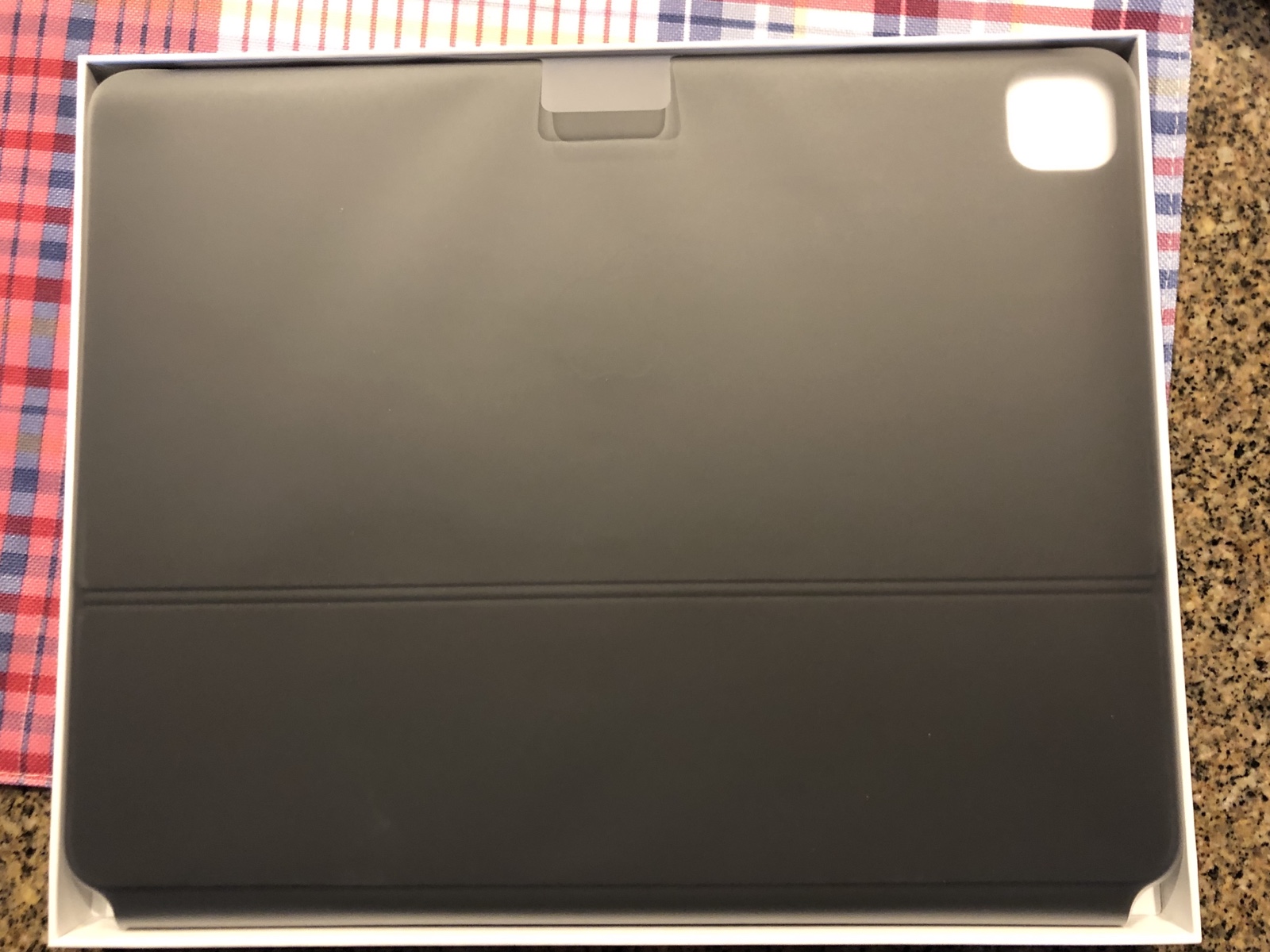
The thing is, as great as the iPad Pro is, it’s felt like it was only about 90% of the way there. The “Smart Keyboard Folio” Apple released with the iPad Pro works well but I’ve always found it a little lacking. The iPad bounced a bit as the case was a little too flimsy, and up until the latest version of iPadOS (13.4), Apple didn’t legitimately support mouse or trackpad use with the iPad. They wanted you to touch the screen. I wanted to touch the screen too, but there are times when I just want to use a touchpad or mouse with my tablet.
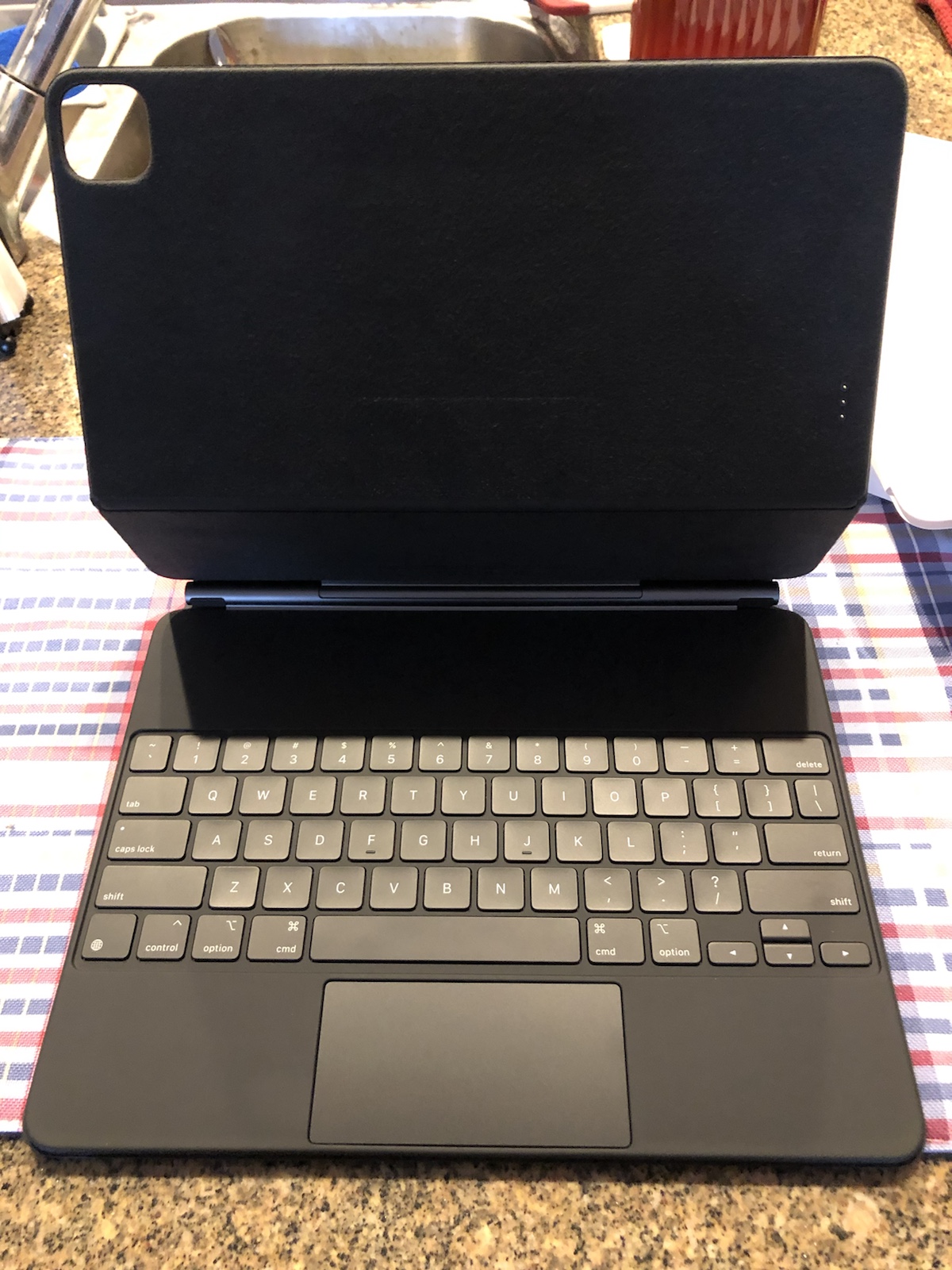
When Apple first announced their new “Magic Keyboard” for the iPad Pro I instantly knew they were filling the gap I had with my user experience. A trackpad and a full blown keyboard was just what this geek needed to embrace iPad living full-time. I made some noises of resistance for a couple of days but then decided, hey, since I’m not flying for the duration of this lockdown, I might as well use a little bit of that budget to buy myself this new Magic Keyboard. After all, it would complete my geek transition to using the iPad Pro full-time.
The Magic Keyboard arrived today. And it’s everything I hoped it would be.
My iPad Pro no longer feels flimsy when in an upright position. The iPad is solid and if I wish to use the touch interface that is native to the iPad experience, I no longer feel like I have to hold the back of the iPad to prevent the whole affair from falling over.
The keyboard is very nice. Ask my husband, I am very picky about keyboards but the Magic Keyboard has a great feel, a comfortable amount of travel and most importantly, it’s part of Apple’s return to “scissor” switches, instead of those awful butterfly switches found on their MacBook line for the latter half of the 2010s. (Though, to be fair, the keyboard on my husband’s 2018 MacBook Pro isn’t awful, though it was a little disconcerting when three keys stopped working for a bit due to one strand of cat hair on the keyboard).
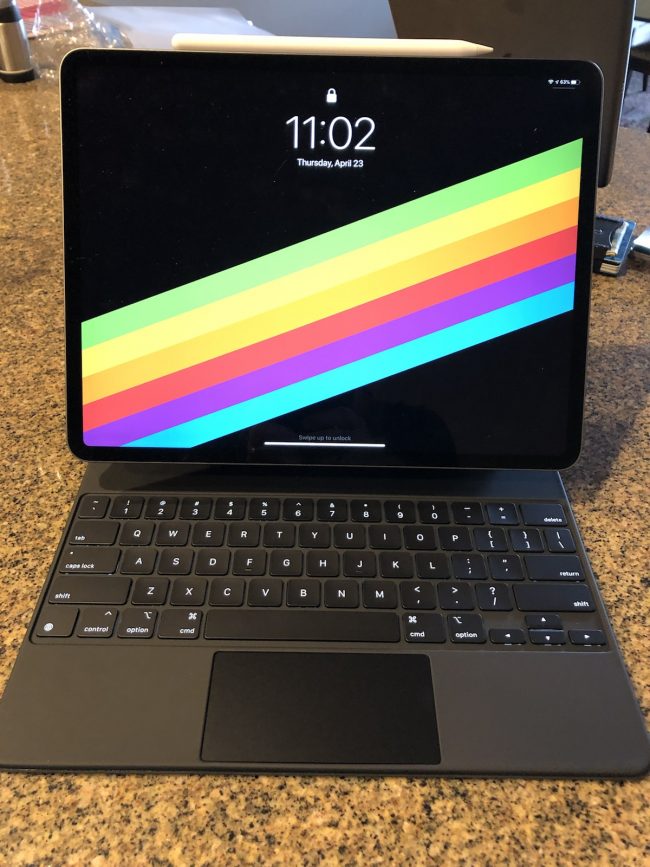
Since the release of iPadOS 13.4 I’ve been using an older style Magic Trackpad to play around with mouse and trackpad support on the iPad. I’m impressed with the way the cursor is handled in this operating system. It shows itself only when it’s necessary and it’s a pleasant, translucent dot that lends itself to the touch interface traditionally found on the iPad. When hovering moving over buttons the buttons have a subtle action and the cursor snaps in place but still freely moves on if you’re intending the move elsewhere. When over text the cursor naturally moves to a text bar and like the round dot, in no way does it look out of place. I’m still getting used to the trackpad gestures; moving around with multitasking feels a little less intuitive than I’d like it to. For example, when I bring a slide over window to show two windows at once on the screen I’m still having a hard time flipping through the available applications for that window.
The Mac keyboard shortcuts works for the most part. The biggest gap I’ve noticed is the inability to close my current application and return to the home screen with a CMD-Q. This is something I do all day long on my work Mac, and not having the functionality work the same way on my iPad is a little weird. To “close” an app, you swipe up on the trackpad with four fingers.

I really like the way the iPad “floats” over the keyboard. I will admit I miss a top row of keys that would traditionally include the function keys and an Escape key. I never realized how many times I hit Escape during the day until I didn’t have that key to bang on. I suppose it’s revealing of my age and heavy use of console applications for much of my computing experience, but I instinctively hit the Escape to stop something happening on my computer. I don’t know if it does anything or if it’s just a comfort action on my part, but I’m finding myself looking for that key a lot. I miss it.
I have no doubt in the magnets holding my iPad Pro in place. They have firmly clamped onto my iPad and it feels much more stable than when I was using my Smart Keyboard Folio before this move. It does take a bit of effort to open the case up from a closed position, and the case is a little heavier than I expected it to be. But we all need to maintain a muscles, right? I am with comment but without complaint on that.
Overall, I’m very pleased with this bit of Retail Therapy and I look forward to using this case for many years to come. I’m hoping Apple with keep it compatible with future form factors of the iPad Pro, because it would be quite nice to be able to keep the keyboard and trackpad and just swap out the iPad Pro for a new one once in a while. I’m currently using a 2018 iPad Pro and it does not look out of place, even though the “hole” in the case is designed for the larger camera area on the 2020 model.
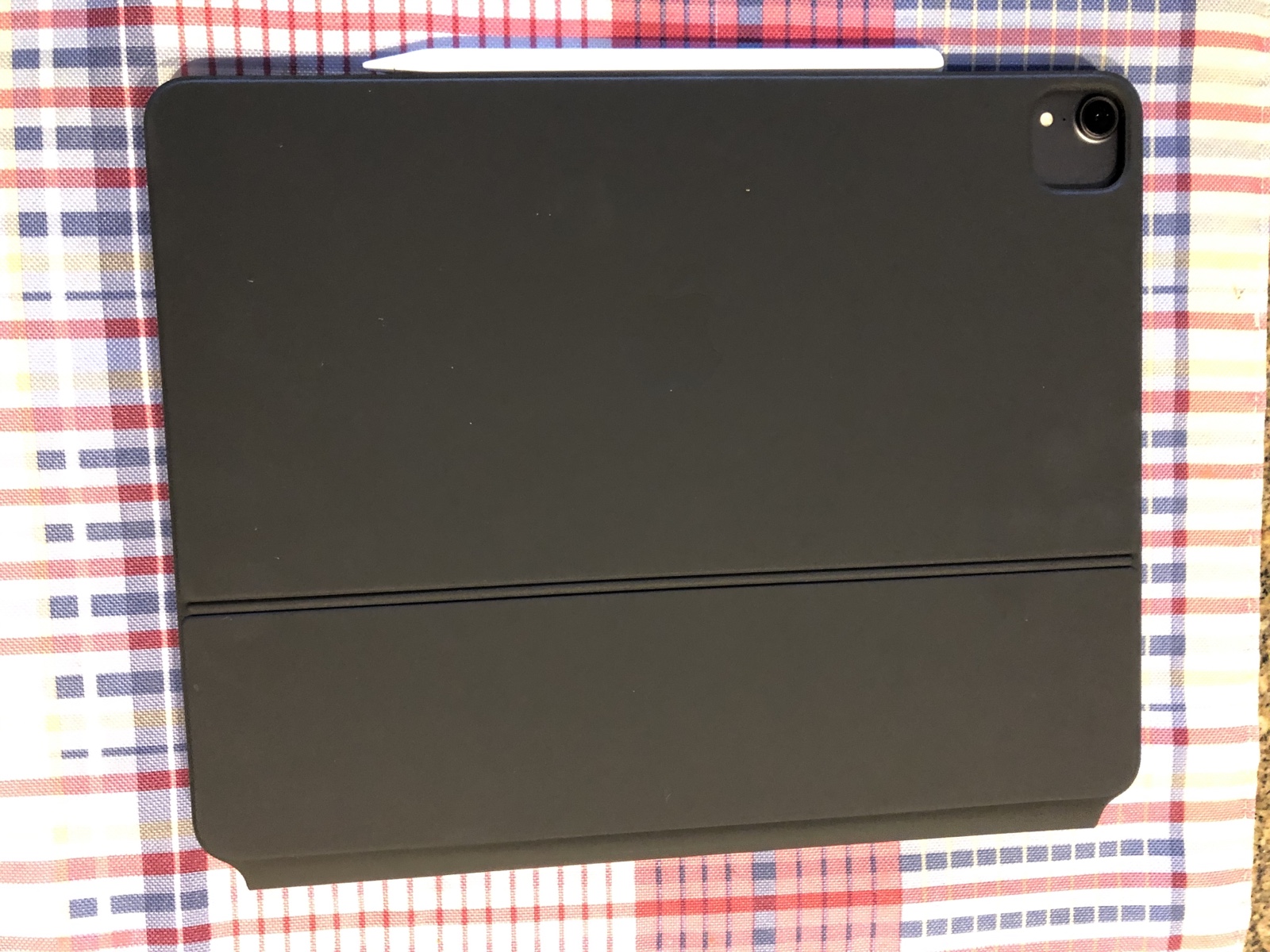
My only concern with the whole thing is the price. This new keyboard was quite expensive and I don’t see average users buying it anytime soon. I’m thinking I paid an early adopter premium with this purchase, but I’m so delighted with the quality of this bit of technology I am without complaint.
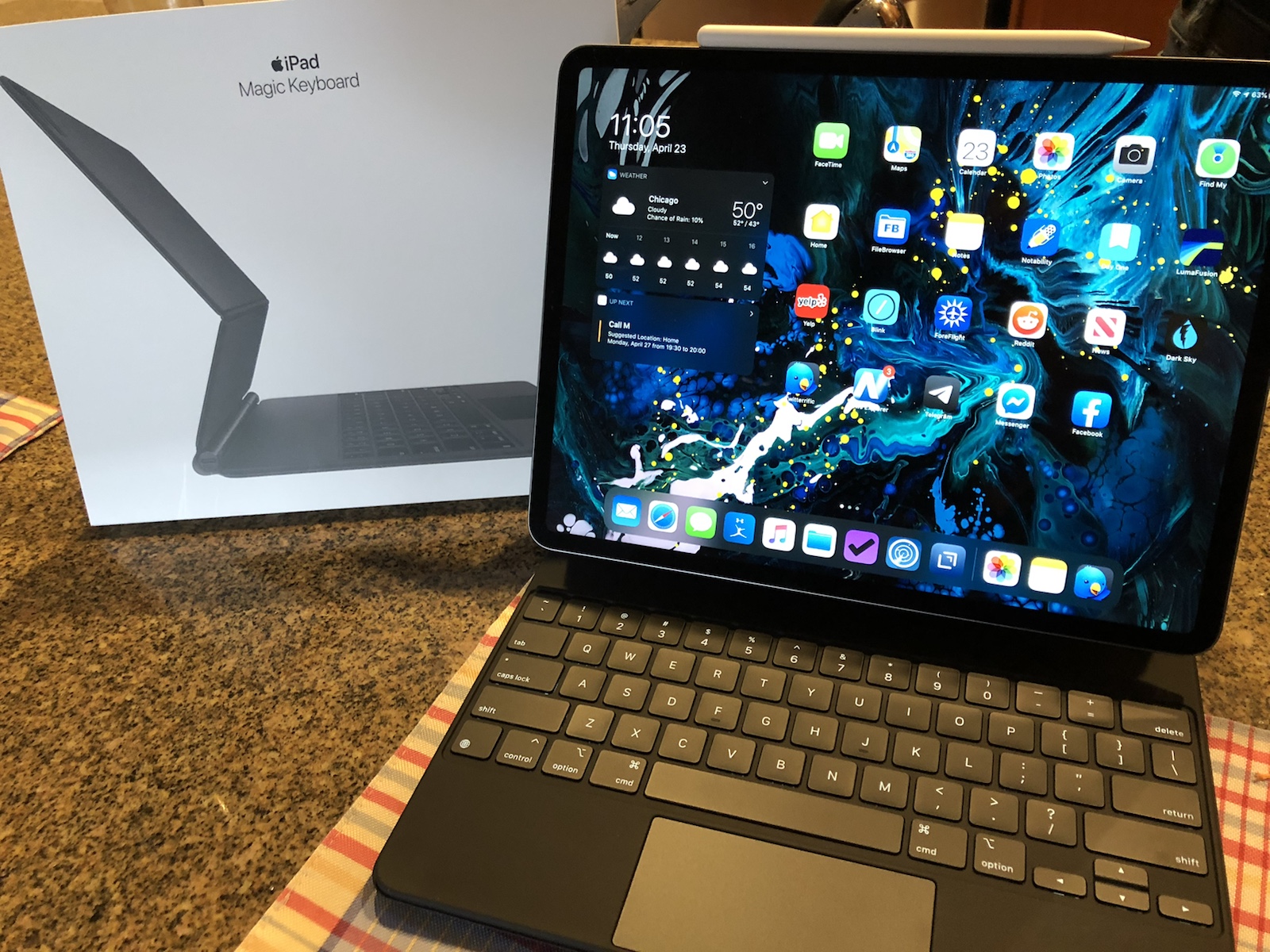
If you’re serious about using your iPad Pro as full time as you can, and you have the budget to make this purchase, you won’t regret it. I’ll continue to share my iPad Pro adventures here. My next big task is to start editing video imported from my GoPro and Garmin cameras here on my iPad Pro instead of relying on my MacBook Pro for the task.
I look forward to sharing the results of my efforts soon.
I’ve decided to create a new blog about my interest in Vintage Point of Sale Systems (electronic cash registers and the like) from the 1970s and 1980s.
If you’re so inclined, you can find it at The Vintage Point of Sale Site.
Might as well use this down time for geeky productivity.


This is a 1983 press photo taken in a Kmart. I don’t know the location of the Kmart, though I can tell you this is one location I had never been in. It would appear the photographer is standing on the checkstand for register #1. I’m surprised to see both registers two and six are designated as express checkouts.
The cashiers are using NCR 255 cash registers, which I’ve never seen in a Kmart. As a vintage technology buff I can tell you the NCR 255 was capable of scanning as early as the mid 1970s, but Kmart really struggled with bringing their store systems into the electronic era. Notice there’s no scanners in the checkstands and the cashier doesn’t have a wired wand anywhere. Undoubtedly the cashier was entering a price and selecting “Key 1”, “Key 2”, etc., as that was the way Kmart designated their departments at the time. Announcements over the PA system would refer to personnel as “Clock” and a number, you had to listen for your “clock” number to know when to respond.
The NCR 255 cash registers were quite sophisticated compared to what I remember from that era at Kmart; the Kmart in Mattydale kept their mechanical cash registers well into the 80s and the Kmart at “Western Lights” in Syracuse had loud NCR 225s that made a lot of banging sounds. Another Kmart near where I went to college had something completely different that wasn’t made by NCR at all.
I have a lot of useless information in my brain.
One thing I found surprising is the stacks of cartons of cigarettes along the express checkout. I had completely forgotten that was a thing back in the day, though now that I think about it I remember the grocery stores in my hometown having a similar arrangement at the registers.
I took a look at the visitor stats for this site for the first time in a very long while; most people come here to visit a page I wrote years ago about the department store chain “W.T. Grants”. Many former employees stop by to reminisce. Other visitors stop by to read about my memories of early computers and cash registers.
I really do enjoy vintage technology. I was doing research on NCR’s minicomputers of the 1970s when I came across this photo via a Google search. Kmart had a huge mish-mash of registers across their stores in the early 1980s until they finally settled down onto one somewhat cohesive system around the same time they ditched the big red “K” with the turquoise “mart”.

That Kmart sign is much bigger than any “Big K” sign I’ve ever seen since that unfortunate switch a couple of decades ago.
Now there’s hardly an Kmarts left in the country. Times are certainly different.

So I’m using downtime to try the new pointer support in iPadOS 13.4. Well, technically I’m using iPadOS 13.4.1 at the moment, but the functionality was fully introduced in 13.4 and I’ve heard great things about.
The things I’ve heard are absolutely on point. Pun intended? Probably?
When the iPad first came out over 10 years ago, the thought was it would be a consumption device. You’d sit back in a chair and casually watch videos, read book, and browse the Internet. As time has gone on, Apple has decided to push the iPad, and more specifically the iPad Pro, as the next generation computer. Their “What Is A Computer?” marketing push has invited users to push the boundaries of what defines a computer.
Since purchasing my iPad Pro back in 2018 I’ve tried to make it my primary personal computing device and I’ve found that it’s about 95% there. As a power user and developer, the only thing I miss from the experience is being able to tinker underneath the hood at a shell prompt, but it’s not an absolute necessity for me. I still have my trusty 2015 MacBook Pro (the last generation before the butterfly keys made an appearance) and that’s working just fine.
Trying a keyboard and trackpad with my iPad Pro today feels like it’s taking the experience to another level. I’m excited about Apple’s release of their Magic Keyboard for iPad Pro coming out next month and I’m going to be pestering my husband to make the purchase. The only thing that gives me pause about that is the missing ESC key in the upper left hand corner, but there’s other ways to single an ESC on a keyboard (I think it’s CTRL-[).
I’m going to work with this setup today and see if this is truly the game changing experience I think it is.
I don’t often get excited about technology in these times, but I’m excited about this.